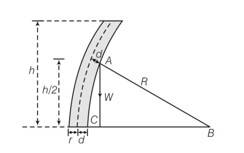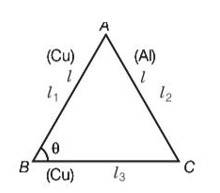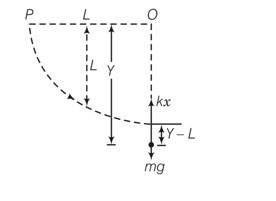physics ncert solutions class 11th
Get insights from 952 questions on physics ncert solutions class 11th, answered by students, alumni, and experts. You may also ask and answer any question you like about physics ncert solutions class 11th
Follow Ask QuestionQuestions
Discussions
Active Users
Followers
New answer posted
4 months agoContributor-Level 10
This is a Multiple Choice Questions as classified in NCERT Exemplar
Answer-a, c
Explanation- as we know F=
V= orbital speed=
Time period of revolution of planet T = =
T2 ……….1
Hence orbit will be elliptical.
F= =g'm
It is clear from equation 1 that its path is parabola.
New answer posted
4 months agoContributor-Level 10
This is a long answer type question as classified in NCERT Exemplar
Till the stone drops through a length L it will be in free fall. After that the elasticity of the spring will force it to a SHM. Let the stone come to rest instantaneously at y.
The loss in PE of the stone is the PE stored in the stretched string .
Mgy=1/2 k(y-L)2
Mgy =
=
Y=
b)in SHM the maximum velocity is attained when the body passes through the equilibrium position i.e when instantaneous acceleration is zero. That is mg-kx=0
so mg=kx
from the conservation of energy
mg=kx
x=mg/k
v2=2gL+mg2/K
v= (2gL+mg2/K)1/2
c)when stone is at lowest position i.e at instantaneo
New answer posted
4 months agoContributor-Level 10
This is a Multiple Choice Questions as classified in NCERT Exemplar
Answer-a, c, d
Explanation- acceleration due to gravity at altitude g'=
At depth d, g'=g (1-d/R)
In both cases value of g decreases
But in case of latitude the value of g increases when we increase
also we conclude from the formula that it is independent upon mass.
New answer posted
4 months agoContributor-Level 10
This is a Multiple Choice Questions as classified in NCERT Exemplar
Answer-c
Explanation- force on B due to A = FBA=
force on B due to C = FBC=
BC = 2AB
FBC=
So it move towards BA
New answer posted
4 months agoContributor-Level 10
This is a long answer type question as classified in NCERT Exemplar
Consider the diagram according, the bending torque on the trunk of radius r of the tree =

When the tree is about to buckle Wd=
If R>>h, then the centre of gravity is at a height l
From 2+ (h/2)2
If d <2+
So d = h2/8R
If wo is the weight /volume
h= ( )1/3r2/3
critical height = h= ( )1/3r2/3
New answer posted
4 months agoContributor-Level 10
This is a Multiple Choice Questions as classified in NCERT Exemplar
Answer-d
Explanation- gravitational mass of proton is equivalent to its inertial mass and independent of presence neighbouring heavy objects.
New answer posted
4 months agoContributor-Level 10
This is a Multiple Choice Questions as classified in NCERT Exemplar
Answer-d
Explanation- asteroids are also being acted upon by central gravitational forces, hence they are moving in circular orbits like planets and obey Kepler's law.
New answer posted
4 months agoContributor-Level 10
This is a long answer type question as classified in NCERT Exemplar
l1=AB ,l2=AC ,l3=BC
Cos =
2l3l1cos =
Differentiating 2( )cos -2
= 2
= d
=d
=d
( + )cos + = + -

sin (1-cos )-
d
= 2
d = change in the angle ABC
=New answer posted
4 months agoContributor-Level 10
This is a Multiple Choice Questions as classified in NCERT Exemplar
Answer-b
Explanation- as observed from the sun two types of forces are acting on the moon one is due to gravitational attraction between the sun and the moon and the other is due to gravitational attraction between the earth and the moon hence total force is not normal.
New answer posted
4 months agoContributor-Level 10
This is a Multiple Choice Questions as classified in NCERT Exemplar
Answer-c
Explanation- As the total energy of the earth satellite bounded system is negative . due to the viscous force acting on the satellite, energy decreases continuously and radius also decreases.
Taking an Exam? Selecting a College?
Get authentic answers from experts, students and alumni that you won't find anywhere else
Sign Up on ShikshaOn Shiksha, get access to
- 65k Colleges
- 1.2k Exams
- 686k Reviews
- 1800k Answers


